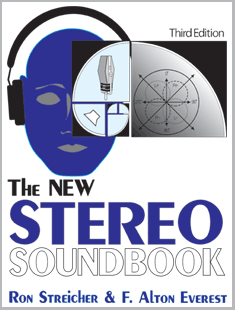From Jerry Bruck
Recording Engineer, New York City
2011 October 13
Quite some years ago, I met and spent some time with a Belgian engineer and instructor (Carl Ceoen) who had taped a Dvorak Slavonic Dance with five mic setups (spaced omnis, panned omnis, and ORTF, NOS, and coincident pairs, as I recall), and presented it as a demo with diagrams of his mic positions. This was at a time when such a paper and presentation were particularly relevant to those of us concerned with accurate stereo reproduction.
In a conversation with Ceoen he told me that the NOS system, that had been in use by the Dutch Radio formerly, had been withdrawn when the ORTF system was adopted by the French radio (using Schoeps microphones). The ORTF system had better positional accuracy than the NOS, and better mono performance, so the Dutch Radio scrapped NOS in favor of ORTF.
This would have been of slight historical importance were it not picked up by Bob Schulein while writing a book on microphones. He gave NOS a similar rating to ORTF, apparently unaware that it had been superseded. Many of my customers bought the book, and I was besieged by inquiries about this "NOS" system. I tried to explain that it was no longer used, but many readers took the book as their Bible, and even today I still encounter customers who inquire about NOS.
From Erik Sikkema
2011 October 16
From 1980 to 1982, I was a trainee with the Chief Engineer of Dutch Radio. My mentor came in 1954 to the Dutch Radio when it was still NRU, and he retired in 1994. While I was there, I also observed several of his colleagues working and memorized their set-ups.
My mentor was a pioneer himself with stereo in the very early 1960s. He assured me that in the beginning they used only XY coincident techniques because everything was being broadcasted mono. Later when stereo broadcasts started, besides XY coincident they often used what he called a “paired XY” — which is in fact very much like your description of the NOS-set-up, but not with this huge distance of 35 cm. As he configured it, “paired XY” used two cardioid microphones (e.g. Neumann KM54s) angled about 90 degrees with their backs together, plug ends touching; this creates a near-coincident configuration, with a capsule spacing depending of the length of the housing, but probably no more than about 20 cm.
According to my teacher, the A-B alike configuration shown with a distance of 35 to 40 cm, as described in your book as well as others by well respected authors, has never been in use, and it was very unlikely there was a protocol about the set-up existing at the Dutch Radio (NOS).
What I subsequently have learned, in a Swedish doctoral thesis by Toivo Burlin, is the same set-up as you describe in your books, described as the NRU stereo set. Although the positioning and distance is precisely alike your description, here the author said it was a set-up in use by the Swedish Radio, called NRU-kopplingen, and it could be used with either omni's or cardioids. This set-up has been used at Swedish Radio in Stockholm. According to Burlin: "My source for NRU-kopplingen is primarily the Swedish engineer Rune Andréasson at Sveriges Radio. NRU-kopplingen was the internal music engineer’s nickname for this microphone set-up. How this eventually is related to real Dutch recording techniques I have not investigated."
As a matter of fact, engineers at the NOS later did use an A-B setup with omni's with a minimum width of 1 meter (e.g. in The Concertgebouw often AKG C414s were used, set to omni). Also in the microphone locker of The Concertgebouw radio studio there was a Neumann SM69fet, an ORTF pair, and I think I even saw a Schoeps 501 stereo microphone. I saw my mentor and his colleagues use several possible combinations of microphones, depending on what the music and the acoustics required. The only time I saw my teacher use a set up like the NOS stereo array was when he used a stereo spot of two shotgun microphones on the organ at the Concertgebouw for the Saint-Saens Third Symphony.
